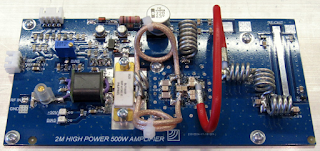Annoyingly the metalwork that I need to move the mechanical side of the project on has still not arrived and there appears to be no indication when it will, which is frustrating! I suppose they'll blame the delays on Covid - that seems to be the go-to excuse for poor service everywhere these days. Fortunately I can get on with software and PCB design, although that too will soon run out of steam with no hardware platform on which to test.
Meanwhile, I have been ruminating on the 50V current monitor design. The issue is that the zero current output from the sensor is Vcc/2 or about 2.5V and at 100mV/Amp sensitivity there was insufficient headroom for a 20A range before the 3.3V limit on the Teensy SBC is reached. I contemplated level shifters, potential dividers and so on but all had significant disadvantages.
Suddenly I had a Eureka moment! I will never have negative current, so why not run the sensor in reverse, so positive current flow results in negative-going sensor output? That way 0A is about 2.5V and 20A is about 0.5V - a range that is entirely within the Teensy's capabilities. A couple of lash-up tests followed and correct operation was observed. Phew! A much better solution. And simpler too. Fewer components on the now redesigned PCB and simpler computing in the software. A win-win situation indeed.
With that change completed I've decided to put PCB Mk1 into production. It'll take about a week for the finished boards to arrive and by then, who knows, I might have the metalwork!I mentioned a few posts back that the fan in the 50V PSU is rather loud. I decided to investigate with a view to a quiet life. It's easy to get the fan out - just four screws but then things started getting complicated. Looking up the fan model number I found that it is indeed noisy, 40dB(A) no less and that it has a "locked rotor" output, which is active if the fan is not rotating. Easy, thought I, just disable the locked rotor input to fool the PSU into believing all is well, then replace the fan with something quieter.
No PSU output! After much head scratching, I finally realised that the PSU also monitors fan current and once I arranged that the PSU ran happily enough. Research indicates that the old fan produces an impressive 1.3m3/min air flow, which probably explains the noise level.As the PSU will never be run even close to flat out and at a very low duty cycle, even in contests, I feel comfortable de-rating that somewhat and have found a suitable looking fan that provides 1.0m3/min at just 24dB(A) - that's 16dB quieter! The fan is on order from RS and should be here tomorrow.
With that I have rather run out of things to do until some more stuff arrives. It's CQWW this weekend and that's always good fun, provided, that is, the forecast 70kt winds don't come to pass. Anything close to that and my tower will definitely be luffed over!









